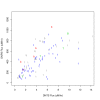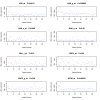On systems and control approaches to therapeutic gain
- PMID: 16638124
- PMCID: PMC1484487
- DOI: 10.1186/1471-2407-6-104
On systems and control approaches to therapeutic gain
Abstract
Background: Mathematical models of cancer relevant processes are being developed at an increasing rate. Conceptual frameworks are needed to support new treatment designs based on such models.
Methods: A modern control perspective is used to formulate two therapeutic gain strategies.
Results: Two conceptually distinct therapeutic gain strategies are provided. The first is direct in that its goal is to kill cancer cells more so than normal cells, the second is indirect in that its goal is to achieve implicit therapeutic gains by transferring states of cancer cells of non-curable cases to a target state defined by the cancer cells of curable cases. The direct strategy requires models that connect anti-cancer agents to an endpoint that is modulated by the cause of the cancer and that correlates with cell death. It is an abstraction of a strategy for treating mismatch repair (MMR) deficient cancers with iodinated uridine (IUdR); IU-DNA correlates with radiation induced cell killing and MMR modulates the relationship between IUdR and IU-DNA because loss of MMR decreases the removal of IU from the DNA. The second strategy is indirect. It assumes that non-curable patient outcomes will improve if the states of their malignant cells are first transferred toward a state that is similar to that of a curable patient. This strategy is difficult to employ because it requires a model that relates drugs to determinants of differences in patient survival times. It is an abstraction of a strategy for treating BCR-ABL pro-B cell childhood leukemia patients using curable cases as the guides.
Conclusion: Cancer therapeutic gain problem formulations define the purpose, and thus the scope, of cancer process modeling. Their abstractions facilitate considerations of alternative treatment strategies and support syntheses of learning experiences across different cancers.
Figures





Similar articles
-
Incidence of common chimeric fusion transcripts in B-cell acute lymphoblastic leukemia: an Indian perspective.Acta Haematol. 2012;128(1):17-9. doi: 10.1159/000338260. Epub 2012 May 5. Acta Haematol. 2012. PMID: 22572394 No abstract available.
-
Targeting signaling pathways in acute lymphoblastic leukemia: new insights.Hematology Am Soc Hematol Educ Program. 2013;2013:118-25. doi: 10.1182/asheducation-2013.1.118. Hematology Am Soc Hematol Educ Program. 2013. PMID: 24319172 Review.
-
Constitutive 53BP1/γH2AX foci are increased in cells of ALL patients dependent on BCR-ABL and TEL-AML1 preleukemic gene fusions.Neoplasma. 2014;61(5):617-25. doi: 10.4149/neo_2014_076. Neoplasma. 2014. PMID: 25244981
-
Probabilistic modeling of DNA mismatch repair effects on cell cycle dynamics and iododeoxyuridine-DNA incorporation.Cancer Res. 2007 Nov 15;67(22):10993-1000. doi: 10.1158/0008-5472.CAN-07-0966. Cancer Res. 2007. PMID: 18006845
-
Targeted therapy: The new lease on life for acute promyelocytic leukemia, and beyond.IUBMB Life. 2012 Aug;64(8):671-5. doi: 10.1002/iub.1055. Epub 2012 Jun 19. IUBMB Life. 2012. PMID: 22714999 Review.
Cited by
-
Automated mass action model space generation and analysis methods for two-reactant combinatorially complex equilibriums: an analysis of ATP-induced ribonucleotide reductase R1 hexamerization data.Biol Direct. 2009 Dec 9;4:50. doi: 10.1186/1745-6150-4-50. Biol Direct. 2009. PMID: 20003203 Free PMC article.
-
Nanovehicular intracellular delivery systems.J Pharm Sci. 2008 Sep;97(9):3518-90. doi: 10.1002/jps.21270. J Pharm Sci. 2008. PMID: 18200527 Free PMC article. Review.
-
dNTP Supply Gene Expression Patterns after P53 Loss.Cancers (Basel). 2012 Nov 20;4(4):1212-24. doi: 10.3390/cancers4041212. Cancers (Basel). 2012. PMID: 23205301 Free PMC article.
-
On model ensemble analyses of nonmonotonic data.Nucleosides Nucleotides Nucleic Acids. 2012;31(2):147-56. doi: 10.1080/15257770.2011.644370. Nucleosides Nucleotides Nucleic Acids. 2012. PMID: 22303993 Free PMC article.
-
A mathematical model of human thymidine kinase 2 activity.Nucleosides Nucleotides Nucleic Acids. 2011 Mar;30(3):203-9. doi: 10.1080/15257770.2011.563765. Nucleosides Nucleotides Nucleic Acids. 2011. PMID: 21491329 Free PMC article.
References
-
- The Integrative Cancer Biology Program http://icbp.nci.nih.gov/
-
- Morrison PF, Allegra CJ. Folate cycle kinetics in human breast cancer cells. JBiolChem. 1989;264:10552–10566. - PubMed
-
- Ciliberto A, Novak B, Tyson JJ. Steady states and oscillations in the p53/Mdm2 network. Cell Cycle. 2005;4:488–493. - PubMed
Publication types
MeSH terms
Substances
Grants and funding
LinkOut - more resources
Full Text Sources
Other Literature Sources
Miscellaneous

